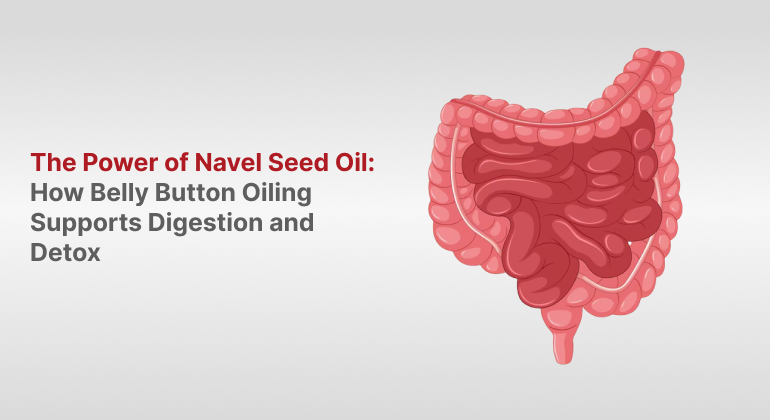In our daily lives, we often face problems like gas, bloating, tiredness, or a heavy feeling in the stomach. These are signs that our digestion may not be working properly or that toxins are building up inside the body. Instead of strong medicines or complicated detox plans, Ayurveda offers a gentle and natural solution — navel seed oiling.
This traditional practice involves putting a few drops of warm oil into the belly button. In Ayurveda, the navel (called nabhi) is considered a very important point. It is believed to be connected to many organs in the body, especially those involved in digestion and detox like the stomach, liver, and intestines. Applying oil to this point can help activate digestion, support bowel movements, reduce bloating, and even improve energy levels.
Our elders often used this method at home, especially for children with upset stomachs or weakness. Now, people are returning to these simple, time-tested remedies as part of daily self-care. Using navel seed oil regularly is easy, safe, and can be done by anyone. It brings balance to the body without side effects, and helps you feel lighter, healthier, and more energetic — all with just a few drops of oil.
What Is Navel Seed Oil and Why It’s Used in Ayurveda
In Ayurveda, the navel—or nabhi—is more than just the center of the stomach. It’s seen as a powerful energy point that connects to many parts of the body through internal pathways. Ancient texts describe it as the starting point of life and a place where 72,000 energy channels (nadis) begin. This is why the navel is given so much importance in traditional healing.
Navel seed oiling is the practice of applying a few drops of warm oil to the belly button to support health and balance. The oil slowly gets absorbed through the skin and reaches deeper tissues. Because the navel is close to the digestive organs like the stomach, intestines, and liver, this method is believed to improve digestion, support detox, and help balance the doshas—especially Vata and Pitta, which are often responsible for gas, acidity, and weak digestion.
In Indian households, this practice was common for relieving stomach pain, weakness, and even for boosting energy. Oils like castor, mustard, and sesame are often used because they are warm and nourishing. Today, as more people turn back to natural remedies, navel seed oiling is once again becoming a part of daily wellness routines—simple, effective, and deeply rooted in Ayurvedic tradition.
Ayurvedic Benefits of Navel Seed Oil for Gut and Detox Health
Ayurveda believes that good health begins with good digestion. When the digestive system is working properly, the body can absorb nutrients well, remove waste smoothly, and stay energetic. But when digestion is weak, it can lead to gas, bloating, acidity, tiredness, and even skin problems. One gentle way to support digestion and detox is through navel seed oiling.
Applying warm oil to the belly button helps stimulate the digestive fire, known as Agni in Ayurveda. A strong Agni means better digestion, less toxin buildup (ama), and a healthier gut. Navel oiling also supports the liver, which plays a big role in cleansing the body and maintaining balance.
Supports Digestion and Bowel Function
Oiling the navel helps relax the muscles around the stomach and intestines. This can lead to better movement of food and waste in the body. People often notice fewer issues like constipation, bloating, or gas when they do it regularly.
Encourages Natural Detox and Liver Health
The oil stimulates the area near the liver and helps improve blood flow. This may support the liver’s ability to remove toxins naturally, without the need for strong medicines or harsh detox plans.
Helps Balance Vata and Pitta Doshas
Vata imbalance can cause dryness, constipation, and restlessness, while excess Pitta may lead to acidity, heat, and inflammation. Navel seed oil, especially when chosen according to your body type, helps calm these imbalances and bring the body back into balance.
How to Use Navel Seed Oil for Detox and Gut Health

Using navel seed oil is a simple, natural practice that doesn’t require much time or effort. When done regularly, it can help improve digestion, support detox, and bring a sense of calm to the body. The key is to follow a gentle routine and choose the right oil for your body type.
This method works best when done at home, in a relaxed setting, preferably before going to bed or early in the morning when the stomach is empty.
When and How Often to Apply Navel Seed Oil
You can apply navel seed oil once a day, either at night before sleeping or in the morning before breakfast. Nighttime is ideal as the body is in rest mode, which helps in better absorption. For best results, do it at least 4–5 times a week as part of your daily routine.
Step-by-Step Belly Button Oiling Method

- Warm the oil slightly — it should be lukewarm, not hot.
- Lie down comfortably on your back.
- Put 3 to 5 drops of the oil directly into your belly button.
- Gently massage around the navel in a circular motion for 2–3 minutes.
- Leave the oil on. You can let it absorb naturally or wipe off any excess after 30–60 minutes.
Tips for Best Absorption and Routine Use
- Do not apply immediately after eating. Wait at least an hour.
- Keep your belly area clean before applying.
- Use high-quality, cold-pressed oils for maximum benefit.
- Stay consistent — the more regular the practice, the better the results.
Choosing the Right Navel Seed Oil for Digestion and Balance
The type of oil you use plays a big role in how effective navel oiling can be. In Ayurveda, each person has a unique body type, or dosha — Vata, Pitta, or Kapha. Choosing the right navel seed oil based on your dosha helps balance your system more effectively and gives better results for digestion, detox, and overall wellness.
Recommended Oils for Different Doshas
- Vata dosha (dryness, gas, cold hands/feet): Use castor oil or sesame oil. These oils are warm and nourishing and help relieve dryness, constipation, and anxiety.
- Pitta dosha (heat, acidity, inflammation): Use coconut oil or ghee. These oils are cooling and calming, and help with acidity and emotional restlessness.
- Kapha dosha (sluggishness, heaviness): Use mustard oil or oils infused with ginger or turmeric. These are stimulating and help with slow digestion and detox.
If you’re unsure of your dosha, you can use sesame oil as a neutral option—it works well for most body types.
Herbal Oils That Support Gut and Liver Function
Some navel seed oils are blended with herbs like ajwain, triphala, or fennel, which further boost digestive health and support liver cleansing. These oils help reduce bloating, improve appetite, and support smooth elimination.
What to Avoid When Selecting Oils
- Avoid heavily perfumed or mineral-based oils.
- Check that the oil is cold-pressed, pure, and food-grade if possible.
- Stay away from expired or low-quality oils, as they may irritate the skin or provide no benefit.
Can Navel Seed Oil Improve Digestion Naturally?
Yes, many people have found that using navel seed oil regularly can help improve digestion in a natural and gentle way. This method doesn’t involve taking anything by mouth, yet it works by stimulating the navel area, which is believed in Ayurveda to be closely connected to the digestive system.
When you apply oil to the belly button, it gets absorbed through the skin and reaches the tissues around the stomach and intestines. This can help relax the abdominal muscles, improve blood flow, and activate digestive functions. People often report feeling less bloated, having more regular bowel movements, and experiencing reduced gas after just a few days of consistent use.
What Users Commonly Experience
Many who use navel seed oil daily say they feel lighter in the stomach, less discomfort after meals, and more energy throughout the day. Over time, it may also support better metabolism and nutrient absorption.
Ayurvedic View on Gut Health Through the Navel
Ayurveda believes that the navel connects to important nadis (energy channels) that lead to the digestive organs. By stimulating this point with oil, you’re supporting the flow of prana (life force) to the gut, which helps balance Agni (digestive fire) and reduce toxin buildup (ama).
Is Navel Oiling Safe and Effective for Everyone?
Navel oiling is generally safe for most people. However, if you have a skin allergy, infection, or open wound near the navel, it’s best to avoid it until fully healed. Pregnant women or those with medical conditions should consult a doctor or Ayurvedic practitioner before starting.
Final Thoughts on the Healing Power of Navel Seed Oil
In a world filled with quick fixes and complex treatments, sometimes the most powerful solutions are the simplest. Navel seed oiling is one such practice—a gentle, natural way to support digestion, detox, and daily wellness. Rooted in ancient Ayurvedic wisdom, this method offers benefits without the need for pills, powders, or strict routines.
By applying a few drops of oil to the belly button regularly, you’re not just caring for your skin—you’re supporting vital systems within your body. It can help relieve common issues like bloating, gas, sluggish digestion, and low energy, all while helping your body stay balanced and calm.
Whether you’re new to Ayurveda or looking to reconnect with traditional Indian self-care practices, navel seed oiling is easy to begin and safe for most people. With regular use and the right oil for your body type, this simple ritual can become a powerful part of your daily routine—bringing comfort, clarity, and balance from the core of your body outward.
Recent Blog : Navel Seed Oil Benefits: An Ayurvedic Detox Ritual
Frequently Asked Questions (FAQs)
What is navel seed oil and how does it work?
Navel seed oil is usually made from warm, nourishing oils like castor, mustard, or sesame. When applied to the belly button, the oil gets absorbed into the skin and may help stimulate digestion, relieve gas, and support natural detox.
Can navel seed oil help with gas and bloating?
Yes, applying oil to the belly button can relax the abdominal area and reduce gas, bloating, and stomach discomfort. Many people use it as a natural remedy instead of taking tablets or syrups.
How often should I use navel seed oil?
For best results, you can use navel seed oil daily, preferably before bedtime. Regular use—at least 4–5 times a week—can improve digestion and energy levels over time.
Which oil is best for belly button oiling?
It depends on your body type. Castor or sesame oil is good for Vata types, coconut oil for Pitta, and mustard oil for Kapha. You can also use herbal oils with ingredients like ajwain or triphala for extra digestive support.
Is belly button oiling safe for everyone?
Yes, it is generally safe for most people. However, avoid it if you have a skin infection or wound near the navel. Pregnant women or those with medical conditions should consult a doctor before starting.







